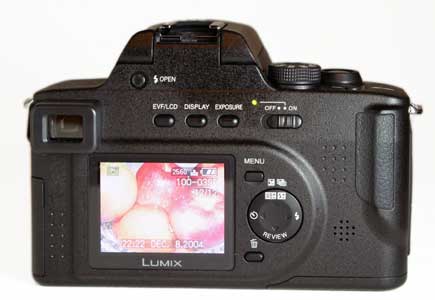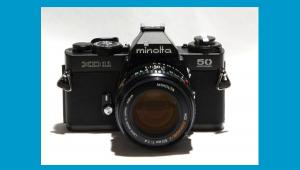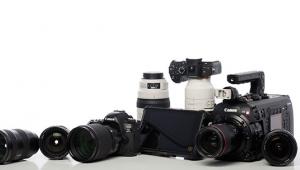Panasonic Lumix DMC-FZ Series
12x Zoom And Image Stabilization Go A Long Way In This Digicam
For starters, what makes the Lumix FZ stand out is the Leica DC Vario-Elmarit 6-72mm/12x optical zoom lens, which translates into 36-432mm, in 35mm parlance. More astounding still is the maximum aperture: f/2.8, which defines a fast lens for this zoom range, one eminently suited to low-light situations. As if that weren't enough, optical image stabilization should help when shooting in subdued light at relatively long shutter speeds, a key feature we'll be testing.
 |
|
|
If it were a prime lens on a 35mm SLR, this glass would be huge! Of course, this is not a 35mm SLR, or even a D-SLR. But it is an EVFD--Electronic View Finder Digital. If you're not a fan of EVFD cameras, this one might turn you around. While it lacks low-light image amplification, the EVF does work well enough in poorly lit situations. The advantage of any EVF is that all the information, including a live histogram in this instance, is in front of you, so there's no need to take your eye away from the subject to check an external display. What's more, the external controls are easily identified by touch, for the most part, keeping you focused on what's in front of the camera. I particularly appreciate the full-information EVF display, since it relieves me of having to don glasses to read the external LCD monitor. It also helps that this camera has an adjustable diopter correction as well.
 |
|
|
What makes the camera appear so imposing is not simply the all black body
and quasi-SLR look. For a midsize compact, it looms large. You see, on the face
of it, the camera in my hands sported a long snout. Except that this protuberance
was not all glass. Half of it is the lens shade, which comes in two sections.
You would think that the deep tube (first section, or "adapter"
as they call it) would suffice--and frankly, it seemed to do the trick.
But Panasonic adds the more typical wave-shaped wide-zoom shade in front of
that.
The front section of the shade has to be removed before using the built-in flash,
to prevent vignetting. And removing it, as well as mounting it, is a bit of
a chore. Still, I use the complete hood assembly, figuring it's there
for a reason. (I'm actually surprised the whole thing doesn't cause
vignetting at wide settings, but it doesn't.
So, now we get to the Leica DC Vario-Elmarit lens itself. For a 12x f/2.8 optic,
it's awfully short, protruding an extra inch when the camera is turned
on (all movements are internal beyond this point). What gives the lens that
striking appearance is its wide girth.
As to the performance of the lens itself, the sharpness was there, but not the
snap. The lens' construction is commendable, boasting a combination of
aspherics and ED glass. But 13 elements in 8 groups apparently take their toll
on contrast.
There is one area where this glass performed exceptionally well, a comment on
its multi-coated optics. I intentionally pointed the lens toward the sun, which
was partially hidden behind a tree, in an effort to create a high-flare situation.
The EVF image showed the vertical flare lines typical of CCD imagers when directed
at a point light source. Despite that, the resultant image was clean and flare-free.
(Caution: do not point a lens directly at the sun, especially a telephoto, as
it may damage the imaging sensor and your eyes.)
Zooming And Focusing
Zooming is electronic, not my favorite form of focal-length control. But here
the zooming steps are discrete and small enough to comfortably let you define
the image area. And the operation is fast--stopping briefly at the end
of the zoom range, to give you time to decide whether to go the distance with
digital zoom--to 4x. Digital zoom holds up fairly well, provided a low
electronic gain setting (ISO) is used, with ISO 200 being the practical limit.
At ISO 400, chromatic noise is obtrusive and intrusive within the normal zoom
range, and is considerably more pronounced with digital telephoto.
In moderate to bright light levels, focusing was fast for a point-and-shoot--nothing
wishy-washy about this system. Even at low-light levels, the camera was not
annoyingly tardy. In fact, there are four AF modes to choose from in the Record
menu: 9-zone, 3-zone, 1-zone, and Spot. For scenics, you may want the most liberal
setting, bringing in the reins for portraits and close-up subjects. After some
initial testing, I found myself most comfortable with 1-zone focusing, especially
after noting that 9-zone focusing takes longer and is not consistent. In low
light and with troublesome subjects, the AF may default to a wide-area sensitivity
when it otherwise fails to find its target in the selected mode.
 |
|
 |
|
 |
|
|
Where AF failed was with moving subjects. It simply was not fast enough. The
camera offers a Manual Focus mode, but the EVF is not crisp enough for you to
focus manually, especially with subjects in motion. There is an AF override
while in Manual Focus, but to be blunt, I don't see the point. I did try
continuous AF once, but that did not seem to help when I was photographing some
ducks in New York's Central Park. On the other hand, I was impressed with
rapid sequence shooting, especially with auto-bracketing. On the flip side,
this camera makes you wait until the images are processed before letting you
proceed.
It is worthwhile pointing out that the lens focuses fairly close without invoking
a macro setting, rewarding me with richly detailed and colorful shots of a bird
of paradise blossom, when taken with flash. The macro setting is on the mode
dial, instead of employing a dedicated switch or button. Focusing in macro is
down to an incredible 1.9" (5cm), at the wide setting. At this near distance,
not only can you not use flash (because of vignetting), but if you're
not careful, the camera may block the available light. Resetting focal length
to a longer setting while in Macro mode should alleviate the vignetting problem,
with flash as well. (To play it safe, I'd recommend removing the entire
lens hood assembly for macro shooting.)
 |
|
|
Holding Steady
The Lumix FZ offers two modes of Optical Image Stabilization (OIS). There's
always the option of turning it off, but I don't think there's enough
of a battery drain to warrant it. The modest 680 maH li ion battery held up
well, although the built-in flash and external monitor were hardly used during
my tests.
Mode 1 OIS keeps the viewfinder image steady as you compose and shoot. Mode
2 only kicks in when the shutter button is pressed, and doesn't assist
with viewing.
Now, here's the rub. If you use Mode 1 to better compose the image, the
stabilization effect during capture will not be as neat and tidy, and some blur
may creep in. If you use Mode 2, the image may be crisper, with image stabilization
brought fully to bear on the problem, but jittery hands may produce an image
that is crooked, or with composition otherwise thrown off somewhat. Initial
tests showed this to be true, with Mode 2 producing sharper results; however,
composition was off more times than it was on. Composition was indeed better
in Mode 1, although shutter delay (as truly minimal as it was) may have allowed
just enough camera movement at times to skew a shot.
 |
|
|
Contrary to the instruction manual, I did observe that OIS was helpful even
when employing 4x digital zoom. However, it failed very decidedly when panning
with moving subjects (as hinted at in the manual). And there were other times
when OIS just didn't seem to help at all--the possible culprit being
light levels that dipped below an allowable threshold.
I found that optical image stabilization on the Lumix FZ20 produced acceptably
sharp results at shutter speeds down to 1/30 sec and what I judged to be critically
sharp images at 1/50, with the lens zoomed out to 432mm (an odd focal length,
I know). In other words, that translates into better than a 4-stop window in
handheld photography, given that the optimum shutter speed would have otherwise
been 1/500 second (as determined by the recommended handheld shutter speed=reciprocal
of lens focal length rule).
The Panasonic Lumix DMC-FZ20 is a serious camera that's also a joy to
use. But I have to qualify that by adding that its reach is longer than its
bite is hard: It can pull in those distant images, but it doesn't do so
with the impact one expects of a Leica lens. Despite some issues I may have
with it, the camera did deliver often enough under conditions where other cameras
would simply have fallen on their face. In short, you can expect the DMC-FZ
to cover a wide range of subjects with aplomb.
There Ain't A Whole Lotta Shakin' Goin' On--and
For Good Reason
The company's website offers the following explanation for its optical
image stabilization technology: "Our MEGA Optical Image Stabilizer helps
minimize the hand movement that causes many photos to look blurry. The key to
this Panasonic technology is a built-in gyrosensor that detects any hand movement.
Once hand movement is identified, a signal is relayed to a tiny microcomputer
inside the camera, which instantly calculates the compensation needed. A linear
motor then shifts the optical image stabilizer lens as necessary to guide incoming
light from the image straight to the CCD. Plus, the Venus Engine II LSI makes
the process from detection to compensation even faster and more accurate. This
helps extend the MEGA Optical Image Stabilizer correction range all the way
to four steps below (i.e., slower than) the shutter speed--generally considered
to be the limit for hand movement compensation."
Pricing And Information
DMC-FZ20: $599; DMC-FZ15: $499
For more info, check out their website: www.panasonic.com.
- Log in or register to post comments

















































